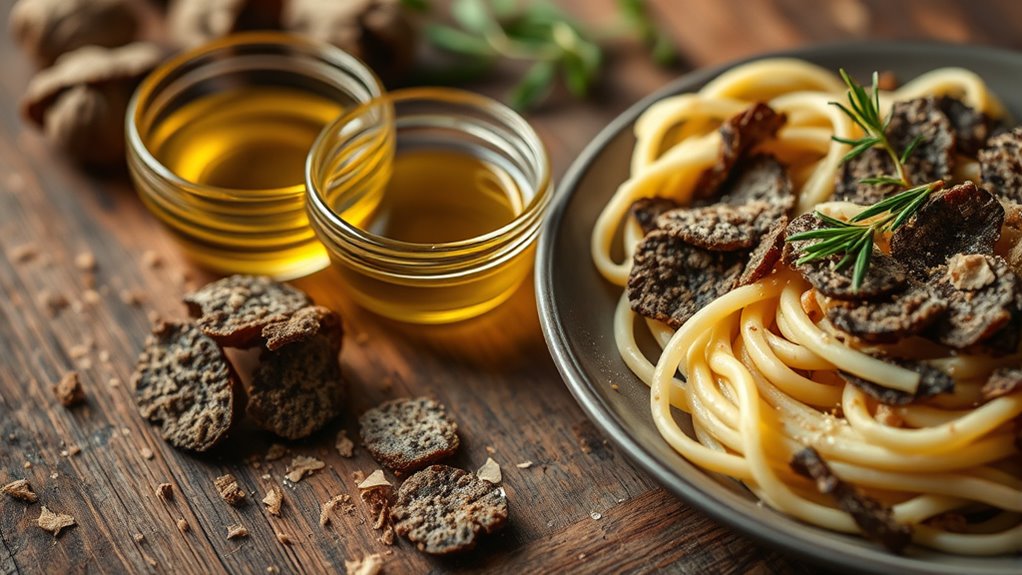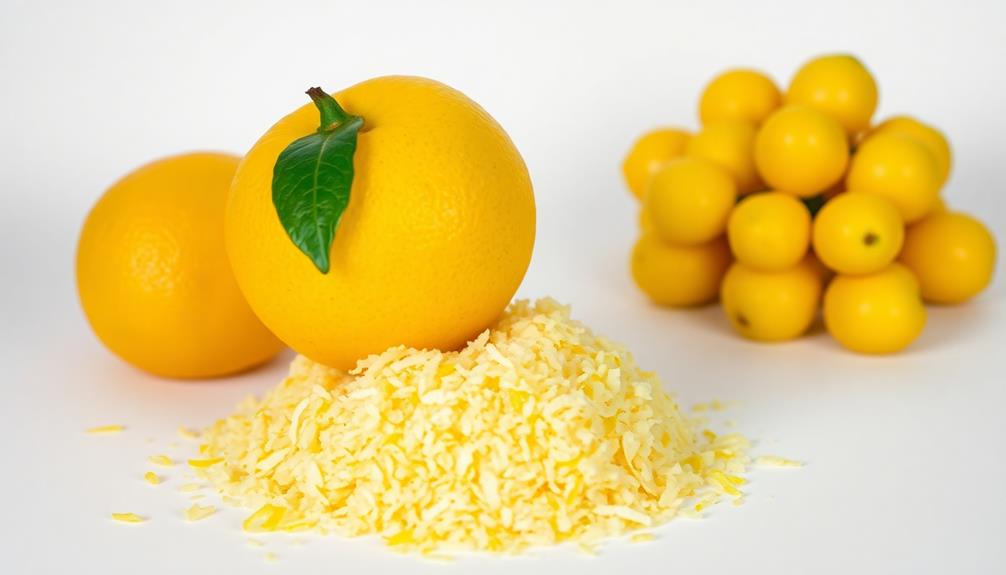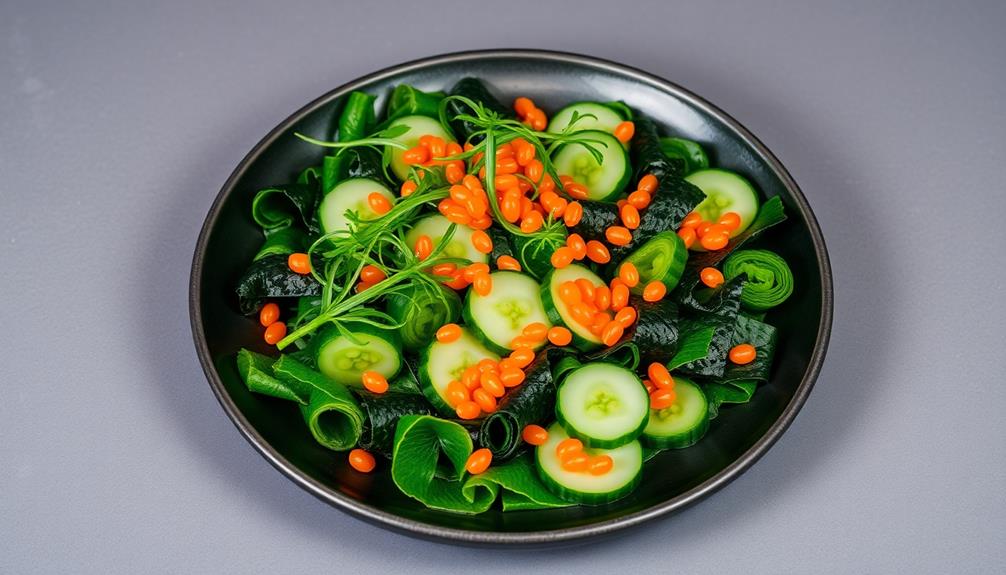To cook with truffles, handle them gently to avoid damage, and add fresh truffles near the end of cooking for maximum flavor. Use truffle oil sparingly as a finishing touch in dishes like pasta, risotto, or eggs to enhance aroma. Proper storage, such as in a paper bag or wrapped in a damp cloth, preserves their quality. Keep exploring to discover more tips that will elevate your truffle culinary skills effortlessly.
Key Takeaways
- Use fresh truffles sparingly, adding them near the end of cooking to preserve aroma and flavor.
- Store fresh truffles in a paper bag in the refrigerator and use within a few days for optimal freshness.
- Drizzle high-quality truffle oil over dishes like pasta, eggs, or risotto for an easy flavor boost.
- Gently handle and avoid overcooking fresh truffles to maintain their earthy scent and firm texture.
- Incorporate truffle shavings raw or lightly cooked to maximize their distinctive aroma and taste.

Truffles are a luxurious ingredient that can elevate any dish, and learning how to cook with truffle oil and fresh truffles reveal a world of rich, earthy flavors. If you’re interested in working with fresh truffles, understanding truffle harvesting is essential. Truffles grow underground, typically near the roots of specific trees like oaks, hazelnuts, and poplars. During truffle harvesting, trained dogs or pigs are used to sniff out the mature fungi, which can be quite elusive. Once located, you carefully dig around the truffle to avoid damaging it and retrieve it gently. Timing is vital because truffles are highly perishable; they need to be harvested at their peak ripeness to guarantee maximum aroma and flavor.
After harvesting, proper truffle storage becomes your priority. Fresh truffles are best kept in a paper bag in the refrigerator, not in plastic, which traps moisture and causes spoilage. You should use them within a few days for maximum flavor, but if you need to store them longer, wrapping the truffles in a slightly damp cloth or rice can help maintain humidity without making them soggy. Remember, truffles are delicate, and their aroma diminishes quickly if not stored correctly. The goal is to preserve their earthy scent and firm texture until you’re ready to incorporate them into your dishes.
When cooking with fresh truffles, it’s important to handle them gently. You don’t need to cook them extensively; in fact, their flavor is most vibrant when added near the end of cooking or simply shaved raw over warm dishes. Truffle oil, on the other hand, offers a more accessible way to impart that distinctive aroma to a variety of dishes. Use it sparingly—just a drizzle can transform pasta, eggs, or risotto into a luxurious experience. Keep in mind that truffle oil is often infused with synthetic flavors, so quality varies. The best approach is to choose high-quality, real truffle oil to truly capture the essence of the fungus.
Frequently Asked Questions
Can Truffles Be Cultivated Outside Their Natural Habitat?
Yes, you can cultivate truffles outside their natural habitat through outdoor farming. Truffle cultivation involves inoculating tree roots with truffle spores and planting them in suitable soil. You need to choose the right environment, like well-drained, calcareous soil, and maintain proper moisture levels. With patience and proper care, outdoor farming allows you to grow truffles in controlled conditions, making it a feasible alternative to natural habitat harvesting.
How Long Does Truffle-Infused Oil Last Once Opened?
Think of truffle-infused oil as a treasure chest—its flavor is precious and needs protection. Once opened, you should use it within 1 to 3 months for the best flavor, but it can last up to a year with proper storage. Keep it in a cool, dark place, and always check for any off smells or changes in color. Proper storage extends its shelf life and preserves its luxurious aroma.
Are There Health Benefits Associated With Consuming Truffles?
You’ll find that consuming truffles offers health benefits, thanks to their antioxidant properties that help fight free radicals. They also support your immune system, making you less prone to illnesses. Including truffles in your diet can boost overall well-being, providing a natural, flavorful way to enhance health. Just remember to enjoy them in moderation, as their unique compounds contribute positively to your health while adding delicious flavor.
What Are the Best Wine Pairings for Dishes With Truffles?
You might think bold reds are best, but lighter wines often better enhance truffle dishes. A crisp Chardonnay or a delicate Pinot Noir can elevate the earthy, umami flavors without overpowering them. These wine pairings boost flavor enhancement, creating a harmonious balance. Experiment with subtle whites and reds to find your perfect match, as the right wine can truly bring out the richness of truffles in your dish.
Do All Truffle Varieties Have Similar Flavor Profiles?
Not all truffle varieties have similar flavor profiles. You’ll notice truffle flavor variations and aroma differences depending on the type. For example, black truffles tend to have a deep, earthy flavor, while white truffles offer a more pungent, garlicky aroma. These distinctions influence how you use them in dishes, so pay attention to each variety’s unique aroma and flavor to maximize their culinary potential.
Conclusion
Now that you know how to elevate your dishes with truffles and truffle oil, remember—these gems are like culinary treasures waiting to transform your cooking. Just as a master painter uses rare colors, you can craft masterpieces with just a touch of truffle. So go ahead, embrace their luxurious aroma and flavor. In the sphere of fine cuisine, you’re now armed to create unforgettable, indulgent moments—like a culinary alchemist turning simple ingredients into gold.










